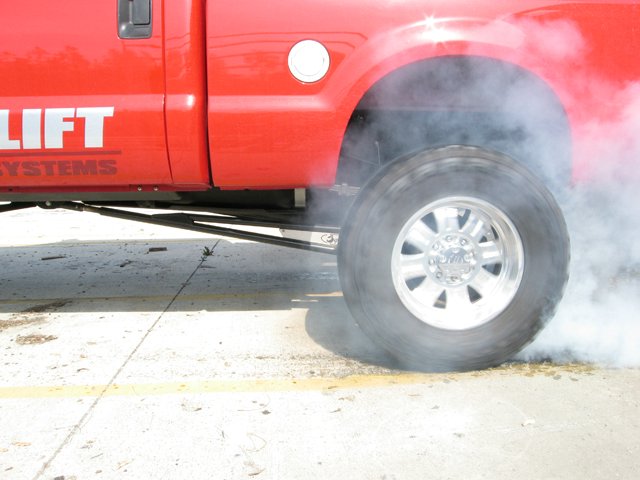
Anti-Rapper Max Traction
By: Tom Morr
Photos By: Tom Morr

Power doesn’t always take the most direct route to the ground. Particularly in modern diesel trucks, hard acceleration can cause torque shock that makes the rear pinion pivot upward. Leaf Springs can deform from the axle rotation. Lift-kit Leaf Springs make the problem worse—they become longer as the spring compresses. Driveline components are stressed, and traction is lost as the rear axle chatters and hops.
Traction bars are the traditional fix for this problem. In fact, they used to be a favorite creation for truck-owning high-schoolers in metal shop. Traction-bar functionality is a result of proper geometry. Their length must be matched to the vehicle, and the bars’ arc of travel must compliment the rear
Superlift’s recent Torque Max Traction Bars take design to the next level. Rigid bars work well as long as the springs compress evenly from side to side. But as turning or uneven terrain cause one side to compress more than the other, rotational force travels through solid bars to their frame mounts. This weakens the bars’ mounts, the truck’s frame or both.
Superlift’s Torque Max series is a new twist on the traditional traction bar. It uses swivel ends to absorb the torsional loads, improving ride and handling. Greasable fittings for the bushings and swivel joints allow noise-free operation.
Two models are available. The Torque Max Standard Series uses a single beam on each side between the rear axle and the truck’s frame, similar to Superlift’s Original Super-Trac Traction Bars but adding the swivel ends. The premium Torque Max Select Series incorporates an additional top brace to each bar plus a gusseted swivel area and a brushed stainless 3-D-logo dress-up panel.
Superlift recommends the Torque Max for trucks running 37”-and-taller Tires and even smaller-tired trucks with rubber-roasting power. Applications are available for many late-model rigs, and the time-proven Super-Trac models are still offered for older trucks. The demo here is on a 2005 Powerstroke F-250.
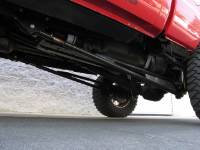
Proper length and geometry determine how well traction bars control wheel-hop. Superlift’s Torque Max bars are also engineered to address torsional loads.
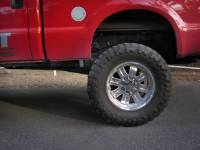
Before: Acceleration causes the rearend’s pinion to rotate up, the springs to compress, the bed to lift and the wheels to hop in search of traction.
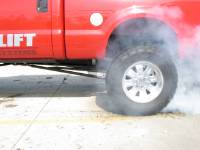
After: The Torque Max Select Series bars keep the rear axle centered in the wheelwells and retain the pinion angle, transmitting the power to the ground while absorbing rotational forces that solid traction bars would transmit to the frame.
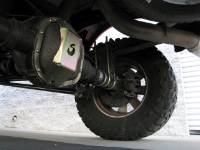
Rear lifts comprised of blocks and add-a-leafs are more prone to axle-wrap than systems that use entire replacement leafpacks.
![]()
Two Torque Max models are offered: a single-beam Standard Series version and the Select Series (shown), which includes an overrider beam and stainless dress-up plate for each bar.
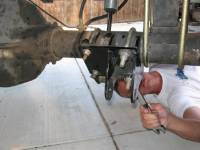
Installation begins by bolting the rear mounting plates to the axle. On new Super Dutys, the passenger’s side bracket relocates the e-brake cable from the stock shock mount.
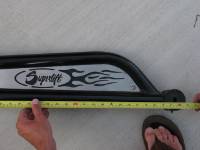
Assemble the bushings and grease fittings on the Torque Max bars. For this 2005 Super Duty, the threaded swivel end is adjusted until the centerlines of the bushings are 71.5 inches apart.
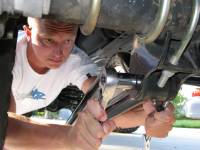
Loosely fasten the Torque Max bar to the rear bracket, then attach the front bracket to the bar to determine the frame-mount location.
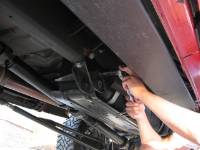
On the driver’s side, the Torque Max’s front bracket uses the gas tank skidplate bolt for its rear fastener. Position this bolt, clamp the bracket in place, mark the necessary mounting holes, drill with a 11/32” bit and secure the bracket with the kit’s fasteners.
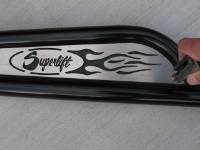
On Torque Max SS (Select Series) models, the stainless dress-up plates attach with the kit’s stainless hardware.
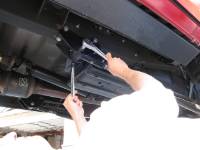
Torque all of the hardware to spec and grease the zerk fittings. Install the opposite side similarly, ensuring that the bushings’ eye-to-eye distance is equal.